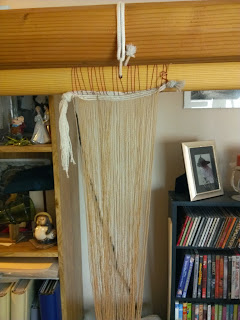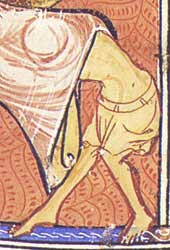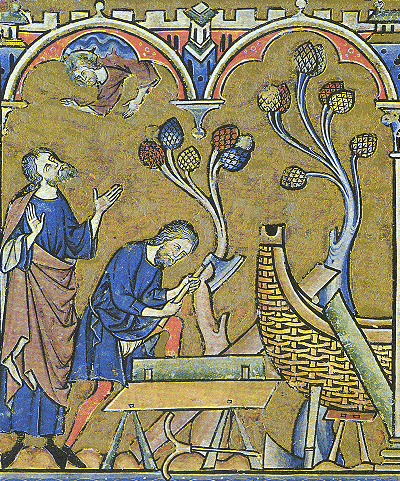 Knitting the heddles was by far the trickiest part of the whole business. Finding clear instructions on how to do this was not so easy, but I managed to work it out for myself after much google searching and watching YouTube videos on knitting heddles for barn looms (not the same sort of heddle at all but it managed to explain the idea). I think the biggest thing left out of the instructions (if you can call them that) that I was able to find is that you really need to work with a small shuttle or netting shuttle, not the ball of yarn. Once I figured this out and got out one of my small table weaving shuttles life was much easier. Also, it was a lot easier (and I do mean A LOT easier, like I might actually do this again easier) to manage everything once I had the idea to pick up the shed I was trying to tie up with a pick up stick and hold it in the forward position with an extra leese stick I tied to my shed stick. This arrangement might not be that clear in the picture, but the idea is to hold the threads in front of the stationary warps so you are not trying to knit the heddles through another set of warp threads. The only problem with this plan is that you have to be extra careful not to twist your warps if you chained them together at the bottom. I twisted a few of them the first time I knit the heddles and ended up having to un-do the heddles AND un-chain the back warp threads to fix the mess. Not a big deal as this is a narrow warp but something to keep in mind time. Knit first, chain second.
Knitting the heddles was by far the trickiest part of the whole business. Finding clear instructions on how to do this was not so easy, but I managed to work it out for myself after much google searching and watching YouTube videos on knitting heddles for barn looms (not the same sort of heddle at all but it managed to explain the idea). I think the biggest thing left out of the instructions (if you can call them that) that I was able to find is that you really need to work with a small shuttle or netting shuttle, not the ball of yarn. Once I figured this out and got out one of my small table weaving shuttles life was much easier. Also, it was a lot easier (and I do mean A LOT easier, like I might actually do this again easier) to manage everything once I had the idea to pick up the shed I was trying to tie up with a pick up stick and hold it in the forward position with an extra leese stick I tied to my shed stick. This arrangement might not be that clear in the picture, but the idea is to hold the threads in front of the stationary warps so you are not trying to knit the heddles through another set of warp threads. The only problem with this plan is that you have to be extra careful not to twist your warps if you chained them together at the bottom. I twisted a few of them the first time I knit the heddles and ended up having to un-do the heddles AND un-chain the back warp threads to fix the mess. Not a big deal as this is a narrow warp but something to keep in mind time. Knit first, chain second. Anyway, once that was done (and it went much faster the second time around), the actual weaving has been pretty straight forward. Beating upwards is a little awkward, but I'm actually having a harder time managing the shuttle stick and the sword beater all at the same time. I feel like I need an extra hand. Luckily with this particular yarn I can do most of my beating with the shuttle stick so I'm not having to use the sword much but it's a bit of a juggling act. Overall the process is not any slower than weaving on a rigged heddle loom. You can see we had some trouble with the table woven header on this piece, which has created a little unevenness in the warp spacing, but I think that will work itself out as I go and when I wash the finish piece. Thinking on it, I think I didn't choose a very good yarn to use for the header, it's not quite the right thickness for such a fine warp.
Anyway, once that was done (and it went much faster the second time around), the actual weaving has been pretty straight forward. Beating upwards is a little awkward, but I'm actually having a harder time managing the shuttle stick and the sword beater all at the same time. I feel like I need an extra hand. Luckily with this particular yarn I can do most of my beating with the shuttle stick so I'm not having to use the sword much but it's a bit of a juggling act. Overall the process is not any slower than weaving on a rigged heddle loom. You can see we had some trouble with the table woven header on this piece, which has created a little unevenness in the warp spacing, but I think that will work itself out as I go and when I wash the finish piece. Thinking on it, I think I didn't choose a very good yarn to use for the header, it's not quite the right thickness for such a fine warp.I still can't quite get my head around tying the heddles for complex twills. I know this can be done, all sort of patterned twills were woven on this type of loom, but with one set of warp threads being stationary I'm not quite sure how you would make something like a diamond twill happen. This might be another example of walk-before-you-run, which I have never been very good at. I'll figure it out.













































